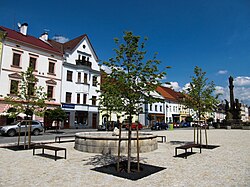Planá (Tachov District)
Planá | |
|---|---|
 Svobody Square, historic centre | |
| Coordinates: 49°52′6″N 12°44′25″E / 49.86833°N 12.74028°E | |
| Country | |
| Region | Plzeň |
| District | Tachov |
| First mentioned | 1251 |
| Government | |
| • Mayor | Martina Němečková |
| Area | |
| • Total | 62.47 km2 (24.12 sq mi) |
| Elevation | 506 m (1,660 ft) |
| Population (2024-01-01)[1] | |
| • Total | 5,692 |
| • Density | 91/km2 (240/sq mi) |
| Time zone | UTC+1 (CET) |
| • Summer (DST) | UTC+2 (CEST) |
| Postal code | 348 15 |
| Website | www |
Planá (also known as Planá u Mariánských Lázní; Czech pronunciation: [ˈplanaː]; German: Plan) is a town in Tachov District in the Plzeň Region of the Czech Republic. It has about 5,700 inhabitants. The historic town centre is well preserved and is protected by law as an urban monument zone.
Administrative parts
[edit]The villages of Křínov, Kříženec, Otín, Pavlovice, Svahy, Týnec, Vížka, Vysoké Sedliště and Zliv are administrative parts of Planá.
Etymology
[edit]The word planá meant 'barren', but it also denoted a wide, open landscape.[2]
Geography
[edit]Planá is located about 10 kilometres (6 mi) northeast of Tachov and 46 km (29 mi) west of Plzeň. It lies on the border between the Teplá Highlands and Upper Palatine Forest Foothills. The highest point is the hill Homole at 681 m (2,234 ft) above sea level.
The Mže River flows through the southern part of the municipal territory. The stream Kosový potok flows along the eastern municipal border and then joins the Mže. The stream Hamerský potok flows through the western part of the municipal territory. The brook Planský potok, its tributary, flows next to the town centre. There are several fishponds in the territory of Planá; the largest of them are Anenský and Labutí.
History
[edit]The first written mention of Planá is from 1251. Planá was located on an important trade route from Nuremberg to Cheb. The oldest part of Planá was built during the 13th and 14th century and at the end of the 14th century it was quite a large town, surrounded by walls and a moat.[3]
In the 16th century, two plague epidemics hit the town, which caused a significant decrease in the population and led to the invitation of colonists from Germany and the beginning of the Germanization of the town. Another misfortune came in the 17th century during the Thirty Years' War, when Planá was conquered and looted several times by various armies.[3]
The Planá estate was owned by several aristocratic families, including Lords of Dobrohošť, Žeberka family, Schlick family, Sinzerdorf family, Nostitz family and Nostitz-Rhieneck family. The most significant owners were the Schlick family. During their reign, mining flourished and the mint was moved to Planá after it ceased to exist in Jáchymov.[3]
Demographics
[edit]
|
|
| ||||||||||||||||||||||||||||||||||||||||||||||||||||||
| Source: Censuses[4][5] | ||||||||||||||||||||||||||||||||||||||||||||||||||||||||
Transport
[edit]
The I/21 road, which connects the D5 motorway with Cheb, passes through the town.
Planá is located on the railway line Plzeň–Karlovy Vary.[6]
Sights
[edit]
The Svobody Square is in the town's historic core. The town hall was built in 1680–1685. The Baroque plague column with the statue of Saint John of Nepomuk on its top is from 1712. Most of the houses on the square are in Gothic or Renaissance style and are protected as cultural monuments.[7]
The oldest town's monument is the Church of Saints Peter and Paul from the 13th century. It is the nationwide important monument with unique frescoes and a rare Romanesque portal with an arched frieze.[7]
The Church of the Assumption of the Virgin Mary is the largest church in Planá. It was built in the 13th–14th century, originally in the late Romanesque style.[7]
The Mining Museum is located in the Ondřej Schlick adit, which was excavated in the 16th century. It documents mining of silver ore in Planá and its surroundings, and existence of mint for minting silver coins, owned the Schlick family.[7]
The castle was continuously built and rebuilt from the 13th to the 20th century and therefore contains building elements from Gothic to the present. Between 1948 and 1991 it served as barracks of the border guard and since then it is abandoned and is crumbling. Its English park is open to the public.[7]
Notable people
[edit]- Siegfried Becher (1806–1873), Austrian political economist
- Hans Tropsch (1889–1935), chemist
- Fritz Wittmann (1933–2018), German politician
- Petr Pavel (born 1961), army general and president of the Czech Republic
- Zdeněk Štybar (born 1985), cyclo-cross racer
- David Vaněček (born 1991), footballer
- Dominik Kahun (born 1995), German ice-hockey player
- Matyáš Bělohradský (born 2001), figure skater
Twin towns – sister cities
[edit] Tirschenreuth, Germany
Tirschenreuth, Germany
References
[edit]- ^ "Population of Municipalities – 1 January 2024". Czech Statistical Office. 2024-05-17.
- ^ Profous, Antonín (1951). Místní jména v Čechách III: M–Ř (in Czech). pp. 366–368.
- ^ a b c "Historie Plané" (in Czech). Město Planá. Retrieved 2024-07-09.
- ^ "Historický lexikon obcí České republiky 1869–2011" (in Czech). Czech Statistical Office. 2015-12-21.
- ^ "Population Census 2021: Population by sex". Public Database. Czech Statistical Office. 2021-03-27.
- ^ "Detail stanice Planá u Mar.Lázní" (in Czech). České dráhy. Retrieved 2024-07-09.
- ^ a b c d e "Zajímavosti města" (in Czech). Město Planá. Retrieved 2021-06-15.
- ^ "Podpis partnerské smlouvy měst Planá a Tirschenreuth" (in Czech). Město Planá. 2019-06-06. Retrieved 2023-08-04.



